|
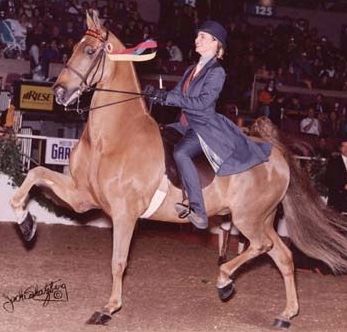
The Saddle Seat rider sits with a balanced, centered seat while sitting in the deepest part of the saddle.
(MacBride)
The weight of the rider should be on the seat bones not on the "pockets" nor on the crotch
and the belly button be brought back to the spine. This will allow the rider to sit with the back straight and the muscles
of the abdominals supporting the lower back to be able to absorb the motion of the horse. The rider should sit deep into the
saddle with their weight sinking down to the ground.

It is important to appreciate the fact that the entire leg is used as one unit from the hip joint and
that the knee and thigh roll into the saddle flap. (Crabtree)
The inner thigh should be stretched down on the saddle with the large muscle on the back of the thigh
behind the leg with the knee down as far as it can be on the saddle.
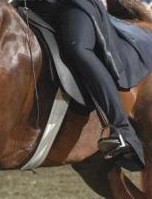
The bending of the knee so the point of the knee is pointing down and letting the
foot come underneath the body will keep the rider's body in the center of the saddle which frees the upper body. (Robinson)
The stirrup leather should be sitting under the inside of the knee joint or just behind
it depending on the ratio of the thigh to shin length. There should be a straight line from the shoulder to the hip to the
heel and the stirrup leather placement can effect this line. The stirrup leather should hang perpendicular to the ground when
viewed from the side.
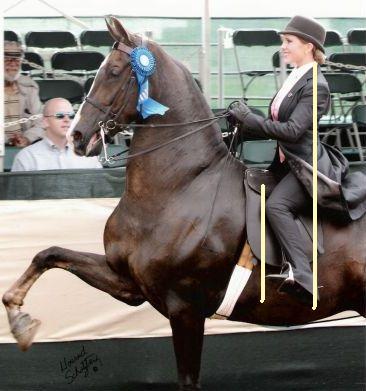
While the weight of the rider goes down from the seat to the heels the leg position can
be built from the foot up. This is important to remember because many position faults can be frequently remedied by studying
the foot position.
The bottom of the stirrup iron should be placed straight across the ball of the foot with the foot centered
in the pad of the stirrup iron.
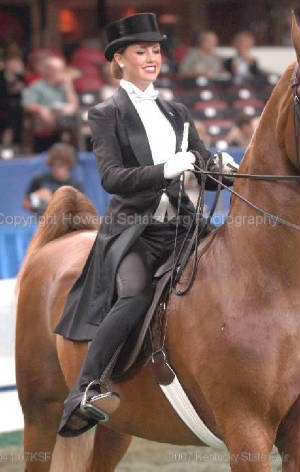
To attain the correct knee and thigh contact the stirrup is used as a lever. By stretching the inner
ankle down and out, the foot actually presses the knee and thigh into the saddle. The beauty of the knee grip through
the foot position is that it permits the greatest economy of effort with a maximum of control and balance. (Crabtree)
Take a look at the stirrup itself. When the bottom of the stirrup is held parallel to the ground it
is held close to the horse's body. Keeping the stirrup in this position requires the rider to wrap the lower leg around the
horse's side which brings the knee and thigh away from the saddle. When the stirrup is pulled away from the horse's side the
inner side of the stirrup becomes lower than the outside of the stirrup. When the foot is placed into this position the big
toe is lower than the little toe with equal pressure across the pad of the stirrup. (Lampe)
The stirrup should only be pulled away from the horse's side enough to roll the knee and thigh into
the saddle. (Crabtree)
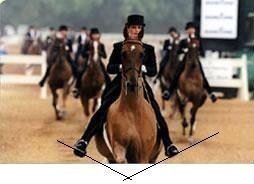
The toe should be pointing straight ahead.
It is important to keep the heel lower than the toe. Heels that are not lowered cause the foot to slide
around in the stirrup or lose it all together and create loose ineffective calves. If the heels are lowered in the correct
place they will keep the foot in the stirrup and result in harder effective and engaged calves that are ready to communicate.
The upper part of the calf should rest on the saddle and not forced away from the horse's side. This
allows the calf to only need the slightest squeeze for invisible leg aids.
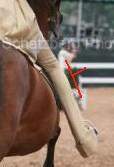
|
| Upper inner calf muscle on saddle. Ankle stretched down and out. |
Why do many Saddle Seat Equitation riders sit more on their zipper than on their seat bones? With horses that
are highly collected many riders will find it easier to sit with their lower backs hollowed. If the position is exagerated,
back is stiff, or the stomach is not supporting the lower back there is a higher chance of lower back problems. To protect
the back it is best to sit on the seat bones as much as possible while engaging the abdominals.
|



